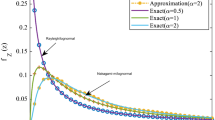Abstract
The multipath self-interference (MSI) with Poisson multipath arrival is investigated in this paper. A number of scenarios are built around the statistical characterization of the magnitude of desired signal and the composite interfering signals, namely, Rayleigh/Rayleigh-Poisson, Rayleigh/Nakagami-Poisson, Nakagami/Nakagami-Poisson, and Rice/Nakagami-Poisson. It is shown that MSI can be statistically characterized in a similar manner as impulse or shot noise. The probability density function of the power ratio of desired to interfering signals is derived which is used to find the expressions for system outrage probability for the considered scenarios.
Similar content being viewed by others
References
Turin, G. L., “A Statistical Model for Urban Multipath Propagation”, IEEE Transactions on Vehicular Technology, Vol. VT-21, no. 1, February 1972, pp. 1–9.
Suzuki, H. “A Statistical Model for Urban Radio Propagation”, IEEE Transactions on Communications, Vol. COM-25, no. 7, 1977.
Hashemi, H., “Simulation of the Urban Radio Propagation Channel”, IEEE Transactions on Vehicular Technology, Vol. VT-28, August 1979.
Suzuki, H. “A Statistical Model for Urban Radio Propagation”, Ph.D Dissertation, University of California, Berkeley, 1975.
Hashemi, H., “Simulation of the Urban Radio Propagation Channel”, Ph.D Dissertation, University of California, Berkeley, 1977.
Saleh, A. M., et al., “A Statistical Model for Indoor Multipath Propagation”, IEEE Journal on Selected Areas in Communications, Vol. SAC-5, no. 2, February 1987, pp. 128–137.
Hashemi, H., “The Indoor Radio Propagation Channel”, Proceedings of the IEEE, Vol. 81, no. 7, July 1993, pp. 941–968.
Rice, S. O., “A Mathematical Analysis of Random Noise”, The Bell System Technical Journal, Vol. 23, 1944 pp. 294–305.
Papoulis, A., “Probability, Random Variables, and Stochastic Processes”, McGraw Hill, 2nd ed., 1984, pp. 379–385 & 136–137.
Edgeworth, F. Y., “The Law of Error”, Camb. Phil. Soc. Proc. 20 (1905), pp. 36–141.
Proakis, John G., “Digital Communications”, McGraw Hill Book Co., 3rd edition, 1995, pp. 37–52.
Nakagami, M. “The m-Distribution - A General Formula of Intensity Distribution of Rapid Fading”, in Statistical Methods in Radio Wave Propagation, pp. 3–36, W. C. Hoffman Ed., Permagon Press, Elmford NY, 1960, pp. 3–36.
Abu-Dayya, Adnan, A. and Beaulieu, N. C., “Microdiversity on Rician Fading Channels”, IEEE Transactions on Communications, Vol. COM-42, no. 6, June 1994, pp. 2258–2267.
Ryzhik, I. M., and Gradshteyn, I. S., “Table of Integrals Series and Products”, Academic Press New York, 1980, pp. 317 & 1039.
Hashemi, H., “Impulse response modelling of indoor radio propagation channels”, IEEE Journal on Selected Areas in Communications, Vol. 11, no. 7, September 1993, pp. 967–978.
Rappaport, T. et al., “Statistical Channel Impulse Response Models for Factory and Open Building Radio Communication System Design”, IEEE Transactions on Communications, Vol. COM-39, no. 5, May 1991, pp. 794–807.
Author information
Authors and Affiliations
Rights and permissions
About this article
Cite this article
Abbas, S., Sheikh, A. Outage Analysis due to Multipath Mobile Radio Reception with Poisson Multiphath Arriva. Wireless Personal Communications 5, 173–193 (1997). https://doi.org/10.1023/A:1008867116637
Issue Date:
DOI: https://doi.org/10.1023/A:1008867116637




